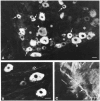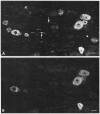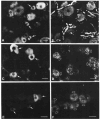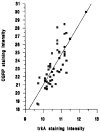Immunocytochemical localization of trkA receptors in chemically identified subgroups of adult rat sensory neurons
- PMID: 7551174
- PMCID: PMC2758238
- DOI: 10.1111/j.1460-9568.1995.tb01143.x
Immunocytochemical localization of trkA receptors in chemically identified subgroups of adult rat sensory neurons
Abstract
Immunocytochemistry has been used to examine the location of trkA, the high-affinity receptor for nerve growth factor, in adult rat dorsal root ganglia, trigeminal ganglia and spinal cord. TrkA immunoreactivity was observed in small and medium sized ganglion cells and in the dorsal horn of the spinal cord. In lumbar L4 and L5 ganglia trkA-immunoreactive cells constitute 40% of dorsal root ganglion cells and range in size from 15 to 45 microns in diameter. Double labelling using markers for various dorsal root ganglion subpopulations revealed that virtually all (92%) trkA-immunoreactive cells express calcitonin gene-related peptide (CGRP) immunoreactivity. In contrast only 4 and 13% of trkA-immunoreactive cells are labelled by the monoclonal antibody LA4 or the lectin Griffonia simplicifolia IB4, markers for small non-peptide-containing cells. Eighteen percent of trkA-immunoreactive cells belong to the 'large light' subpopulation, identified by their strong immunostaining by the neurofilament antibody RT97. TrkA immunoreactivity in the dorsal horn is heaviest in laminae I and II outer, has a similar distribution to CGRP, and is depleted by dorsal rhizotomy. Our results show that trkA-expressing cells in dorsal root ganglia correspond almost exactly with the CGRP, peptide-producing population. The receptor is present not only on cell bodies but also on central terminals. Non-peptide-containing small cells, which constitute 30% of dorsal root ganglion cells, are not trkA-immunoreactive and therefore most probably are functionally independent of nerve growth factor.
Figures








References
-
- Alvarez FJ, Rodrigo J, Jessell TM, Dodd J, Priestley JV. Ultrastructure of primary afferent fibres and terminals expressing alpha-galactose extended oligosaccharides in the spinal cord and brainstem of the rat. J Neurocytol. 1989;18:631–645. - PubMed
-
- Alvarez FJ, Moms HR, Priestley JV. Sub-populations of smaller diameter trigeminal primary afferent neurons defined by expression of calcitonin gene-related peptide and the cell surface oligosaccharide recognized by monoclonal antibody LA4. J Neurocytol. 1991;20:716–731. - PubMed
-
- Ambalavanar R, Morris R. The distribution of binding by isolectin I-B4 from Griflonia simplicifolia in the trigeminal ganglion and brainstem trigeminal nuclei in the rat. Neuroscience. 1992;47:421–429. - PubMed
-
- Andreev N, Inuishin M, McMahon SB. Nerve growth factor acutely enhances the responsiveness of dorsal horn neurones to noxious heat. Soc Neurosci Abstr. 1994;20:455.16.
-
- Arvidsson U, Risling M, Frisen J, Piehl F, Fried K, Hökfelt T, Cullheim S. TrkC-like immunoreactivity in the primate descending serotoninergic system. Eur J Neurosci. 1994;6:230–236. - PubMed
Publication types
MeSH terms
Substances
Grants and funding
LinkOut - more resources
Full Text Sources
Other Literature Sources
Research Materials

